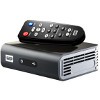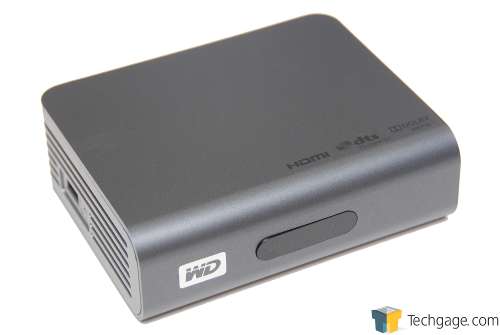- Qualcomm Launches Snapdragon 4 Gen 2 Mobile Platform
- AMD Launches Ryzen PRO 7000 Series Mobile & Desktop Platform
- Intel Launches Sleek Single-Slot Arc Pro A60 Workstation Graphics Card
- NVIDIA Announces Latest Ada Lovelace Additions: GeForce RTX 4060 Ti & RTX 4060
- Maxon Redshift With AMD Radeon GPU Rendering Support Now Available
WD TV Live Plus Media Player

We took a look at ASUS’ O!Play media player a couple of weeks ago, and now we’re checking out WD’s spin on things, with its TV Live Plus. In addition to the fact that it supports a multitude of media formats, it has a great design, dual USB ports, HDMI and Component connectivity, and in our testing, also offered great performance.
Page 4 – Usage Continued; Final Thoughts
As it is, the WD TV Live Plus is only the second such media player I’ve used, but I have to say that it impressed the heck out of me. While ASUS’ O!Play was just as full-featured, if not a bit moreso in certain regards, it had other issues that held me back from being too impressed. But after taking a look at WD’s take on a media player, I’m impressed by how good things can get.
First, the design of the device is quite nice, with clean design cues and a small frame. Regardless of your setup, this should look nice next to your TV or display. Second, it offers both HDMI and composite/component support, which is a step-up from the O!Play’s lone HDMI support. Then there’s the fact that there’s not one, but two USB ports for external storage… the potential is huge.
Likewise, I found the interface to be a pleasure to use overall, with very responsive menus and quick loading of features. On occasion, I’d experience some loading lag when reading media off of a network appliance, but that seems to be common on these devices. It would be nice, however, that if a loading sequence gets “stuck”, that the process could be stopped. I couldn’t find a way to do that here, but fortunately, I never had a time when the loading would be infinite. An error will pop up at some point.
One of the things that stood out most for me when comparing the two media players I’ve looked at so far is that the performance of the WD TV Live is quite good, especially when dealing with HD content. On the O!Play, pushing the pause button on the remote would result in a 2 or 3 second wait before the movie was actually paused. On the WD TV, the effect was instant, and likewise, unpausing was also instant.
The only time the performance could be considered lacking is when fast-forwarding or rewinding HD content, where on occasion, the movie would take a couple of seconds to begin playing again. This isn’t much of a surprise though given that I was dealing with massive files (10GB minimum), and even on a super-fast PC there can be similar lag.
In all of the content I threw at the WD TV, I didn’t have any issues or gripes to speak of. The exception is that playing large Blu-ray rips was a problem, which isn’t due to the device itself, but the fact that the network became the bottleneck. In one example, the movie “War” rips to almost exactly 40GB, and when played back, it lags horribly. Movies at 25GB and under ran just fine. It can be assumed that most people aren’t going to be running direct Blu-ray rips, but if you are, bear this issue in mind.
In looking around the Web, I’ve found that there has been a number of complaints regarding subtitles, but in my experience, I found them to be quite good. I regret forgetting to take a photo to give an idea of how they look, but usually, they could differ from movie to movie. In most cases, the fonts were large and very crisp and generally hovered around 10% up from the bottom of the screen. Multiple languages were supported from English to French to Spanish to Chinese to Thai to Korean and whew… chances are your preferred subbed language will be supported.
Image quality was also very good, and in all the Blu-ray’s I tested, I couldn’t tell the difference between running the movie off my PlayStation 3 or the WD TV Live. DVD’s did leave a bit to be desired though, as the quality wasn’t near as good as if I ran the disc off my PS3 or PC. On the photo side, the image quality was fantastic, and I didn’t have the issue of improper scaling as I did with the O!Play.
The ease of connectivity impressed me also with the device, because I easily logged into my shared folders on my desktop PC and NAS box without issue, and navigating once in was a fast process. You have the option to either connect to a proper media device or shares, so you have more than one way to connect and grab your media.
In the end, I am having a hard time coming up with some major complaints, because from all of my testing, the WD TV Live far exceeded my expectations. Yes, it well deserves our Editor’s Choice award. The “Plus” version of the WD TV Live carries a ~$30 premium and it’s pretty much only Netflix to thank. The non-Plus version for non-Netflix subscribers runs around ~$90.
Because a media player has a broad feature-set, I am bound to have missed mention of certain things. If you are considering the WD TV Live and aren’t sure if it can do something you need it to, please feel free to post in our forums and I’ll check it out.

WD TV Live Plus
Discuss this article in our forums!
Have a comment you wish to make on this article? Recommendations? Criticism? Feel free to head over to our related thread and put your words to our virtual paper! There is no requirement to register in order to respond to these threads, but it sure doesn’t hurt!
Support our efforts! With ad revenue at an all-time low for written websites, we're relying more than ever on reader support to help us continue putting so much effort into this type of content. You can support us by becoming a Patron, or by using our Amazon shopping affiliate links listed through our articles. Thanks for your support!






